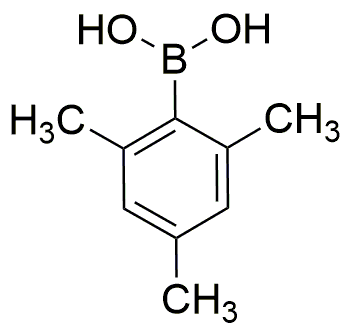2,4,6-Trimethylphenylboronic acid is widely utilized in research focused on:
- Organic Synthesis: This compound serves as a key reagent in Suzuki-Miyaura cross-coupling reactions, facilitating the formation of carbon-carbon bonds, which is essential for creating complex organic molecules.
- Pharmaceutical Development: It plays a significant role in drug discovery, particularly in the synthesis of biologically active compounds, enhancing the efficiency of developing new medications.
- Material Science: The compound is used in the development of advanced materials, such as polymers and nanomaterials, due to its ability to modify surface properties and improve material performance.
- Sensor Technology: Its unique properties make it suitable for creating sensors that detect specific biomolecules, which is crucial in medical diagnostics and environmental monitoring.
- Bioconjugation: This boronic acid derivative is utilized in bioconjugation techniques, allowing researchers to attach biomolecules to surfaces or other molecules, enhancing the functionality of biosensors and drug delivery systems.
General Information
Properties
Safety and Regulations
Applications
2,4,6-Trimethylphenylboronic acid is widely utilized in research focused on:
- Organic Synthesis: This compound serves as a key reagent in Suzuki-Miyaura cross-coupling reactions, facilitating the formation of carbon-carbon bonds, which is essential for creating complex organic molecules.
- Pharmaceutical Development: It plays a significant role in drug discovery, particularly in the synthesis of biologically active compounds, enhancing the efficiency of developing new medications.
- Material Science: The compound is used in the development of advanced materials, such as polymers and nanomaterials, due to its ability to modify surface properties and improve material performance.
- Sensor Technology: Its unique properties make it suitable for creating sensors that detect specific biomolecules, which is crucial in medical diagnostics and environmental monitoring.
- Bioconjugation: This boronic acid derivative is utilized in bioconjugation techniques, allowing researchers to attach biomolecules to surfaces or other molecules, enhancing the functionality of biosensors and drug delivery systems.
Documents
Safety Data Sheets (SDS)
The SDS provides comprehensive safety information on handling, storage, and disposal of the product.
Product Specification (PS)
The PS provides a comprehensive breakdown of the product’s properties, including chemical composition, physical state, purity, and storage requirements. It also details acceptable quality ranges and the product's intended applications.
Certificates of Analysis (COA)
Search for Certificates of Analysis (COA) by entering the products Lot Number. Lot and Batch Numbers can be found on a product’s label following the words ‘Lot’ or ‘Batch’.
Número de catálogo
Número de lote/lote
Certificates Of Origin (COO)
This COO confirms the country where the product was manufactured, and also details the materials and components used in it and whether it is derived from natural, synthetic, or other specific sources. This certificate may be required for customs, trade, and regulatory compliance.
Número de catálogo
Número de lote/lote
Safety Data Sheets (SDS)
The SDS provides comprehensive safety information on handling, storage, and disposal of the product.
DownloadProduct Specification (PS)
The PS provides a comprehensive breakdown of the product’s properties, including chemical composition, physical state, purity, and storage requirements. It also details acceptable quality ranges and the product's intended applications.
DownloadCertificates of Analysis (COA)
Search for Certificates of Analysis (COA) by entering the products Lot Number. Lot and Batch Numbers can be found on a product’s label following the words ‘Lot’ or ‘Batch’.
Número de catálogo
Número de lote/lote
Certificates Of Origin (COO)
This COO confirms the country where the product was manufactured, and also details the materials and components used in it and whether it is derived from natural, synthetic, or other specific sources. This certificate may be required for customs, trade, and regulatory compliance.


